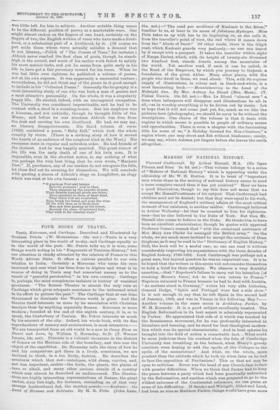FOUR BOOKS OF TRAVEL.
Tunis, Kairouan, and Carthage. Described and Illustrated by Graham Petrie. (W. Heinemann. 16s. net.)—Tunis is a very interesting place in the world of to-day, and Carthage equally so in the world of the past. Mr. Petrie tolls us, it is true, some • things worth noting in his "Fragments of Tunisian History," but our attention is chiefly attracted by the relation Of France to this North African State. It offers a curious parallel to our own relation to India. Certainly a Moroccan who turns his oyes eastward and sees what has been done in Algiers and what is in 'course of doing in Tunis may feel somewhat uneasy as to the result of "peaceful penetration" in his own country. Carthage is, perhaps, the moat conspicuous instance in history of vanished greatness. "The Roman Theatre is almost the only ruin at .Carthage which gives adequate assistance to the unlearned mind in its effort to picture the past." The Carthago that at one time threatened to dominate the Western world is gone. And the theatre itself interests us more by its association with Christian martyrs than by anything especially Roman. Kairouan is more modern ; founded at the end of the eighth century, it is, so to speak, the Canterbury of Tunisia. Mr. Petrie interests us much by his account of the city. Indeed, his whole book, with its fine .reproductions of scenery and architecture, is most attractive,— We are transported from an old world to a new in Camp Fires on Desert and Lava, by William T. Hornaday, Sc.D. (T. Werner Laurie, 10s. not). Pinacate is a volcanic mountain in the district of Sonora on the Mexican side of the boundary, and this was the -object of the expedition. Dr. Hornaday tells the story of how he ..and his companions got there in a lively, sometimes, we are Inclined to think, in a too lively, fashion. He describes the creatures which they saw—antelopes, wild sheep, coyotes, and, . not less important, snakes—the birds, the plants, the plains of rlava, or alkali, and many other curious details of a country
• Which may almost be described as undiscovered. The, illustra- tions are highly interesting representations of Nature, the giant cactus, sixty feet high, for instance, reminding us of that very strange horticultural fad, the monkey-puszle.—Kashmir : the • Land of Streams and Solitudes. By H. R. Pine, (John -Lane.
21s. net.)—" The road par excellence of Kashmir is the River," familiar to us, at least in its name of fabu2osus Hydaspes. Miss Pine takes us up with her to its beginning, or, as she calls it, from the traveller's point of view, the end where it comes down from the "Abode of Snow," Of other roads, there is the Gilgit road, which Kashmir guards very jealously,—no one can travel by it except with a passport. It takes the traveller within sight - of Nanga Parbak which, with its height of twenty-six thousand two hundred feet, stands fourth among the mountains of the world. Yet another road, if such it can be called, is the Road of the Emperors, by which you journey to Gujerat, foundation of the great Akbar. Many other places, with the people who dwell in them, we read about. This, with its copious supply of illustrations, in colour and in black-and-white, is a most fascinating book.—Mountaineering in the Land of the Midnight Sun. By Mrs. Aubrey Le Blond (Mrs. Main). (T. Fisher Unwin. 108. 6d. net.)—Mrs. Le Blond "almost sees ". a time when letterpress will disappear and illustrations be all in all,—as in worship everything is to be driven out by music. Lot us hope that it will not come just yet, for, much as we like the pictures here (photographs), we should be sorry to be without the descriptions. One charm of the volume is that it deals with regions to which access is possible to people of ordinary means and opportunities. There is even a chapter.with the fascinating title for some of us, "A Holiday Ground for Non-Climbers," a region where one may shoot and fish without .hindrance; surely, we may say, where Astraea yet lingers before she leaves the earth altogether.
























































 Previous page
Previous page